| |
|
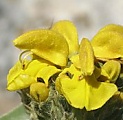 | |
| MaltaWildPlants.com by Stephen Mifsud |

|
| |
|
|
 |  |  |  |
| External Links: |
|
Clinopodium nepeta (Lesser Calamint) |
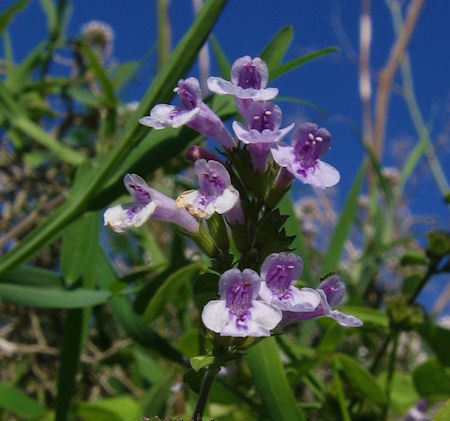
Clinopodium nepeta (LAMIACEAE.)
Images for this profile are taken from the Maltese Islands after year 2000. |
|
| Nomenclature |
Species name : | Clinopodium nepeta (L.) Kuntze | Authority : | | Synonyms :
(basionym or principal syn.) |
Melissa nepeta
L.
Synonym that was used for long in Malta:
Calamuntha nepeta
(L.) Savi
Full list of synonyms :
[Euro+Med]
[PlantList]
[IPNI]
[POWO]
[Catalogue of Life]
[Worldplants.de]
|
Plant Family : | Lamiaceae Lindl. (= Labiatae )
(Mint Family) | English name(s) : | Lesser Calamint, Nepitella, Basil thyme | Maltese name(s) : | Kalaminta, Kammilta | Status for Malta : | Indigenous. Present on the Maltese islands before man | Name Derivation : |
Clinopodium:
nepeta: Alluding to the resemblance with plants of Nepeta (catmint) - another Genus in the mint family. The name may have connection with a type of ground ivy from Nepete, named for an Etruscan town which the plant was found in. (Latin origin )
| Remarks : | |
|
|
| Morphology and structure |
PLANT STRUCTURE: |
Character | Growth Form | Branching | Surface |
Description | | | |
General
Picture | 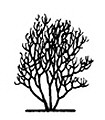 | 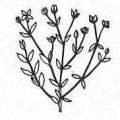 | 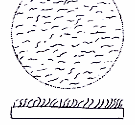 |
|
LEAVES: |
Character | Arrangement | Attachment | Venation |
Description | | | |
General
Picture |  | 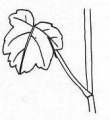 |  |
| |
Character | Leaf Shape | Leaf Margin | Remarks |
Description | | | Scent Leaves have a pleasant aromatic mint-like scent described as a cross between that of Mint and Oreganum. |
General
Picture |  | 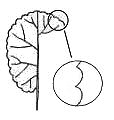 |  |
|
FLOWERS: |
Character | Colour | Basic Flower Type | No. of Petals | No. of Sepals |
Description | Lilac Some specimens are almost white and others have a darker violet colour. | | 2 Upper and lower petals each being lobed. | 1 Fused tubular calyx wth 5 teeth at the mouth. |
General
Picture | | 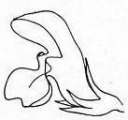 |  |  |
| |
Character | Inflorescence | Description | Ovary | Stamens |
Description | | The corolla is composed of two main petals, the upper with 2 small lobes and the lower (the lip) with 3 rounded lobes. The lower half of the corolla is fused into a tube which is inserted in a tubular calyx. The lilac corolla is decorated by dark-violet speckles and brush of white hairs at its mouth. | | |
General
Picture |  |  |  |  |
| |
Character | Scent | Average Flower Size | Pollen Colour | Other Notes |
Description | Mild fragrant | 12mm x 9mm Length of corolla tube x diameter of corolla. | Lilac | - |
|
SEEDS: |
Character | No. Per Fruit | Shape | Size | Colour |
Description | 1-4 (4 maximum). | Spherical | 1mm | Dark brown |
General
Picture |  |  |  |  |
|
FRUIT AND OTHER BOTANICAL DATA: |
Character | Fruit Type | Colour of Fruit | Subterranean Parts | Other Notes |
Description | | Green Ref. to the colour of the calyx. | | Stem cross-section A distinct square-shaped cross section. |
General
Picture |  |  |  |  |
|
|
| Plant description and characters | |
Life Cycle: |
|
Growth Form: |
HEMICRYPTOPHYTE (prostate plants with flowers close to the ground) |
Habitat: |
Pre-desert scrub and high garigue. Frequently found in valleys sides and vegetated rocky places |
Frequency: |
Frequent |
Localities in Malta: |
|
Plant Height: |
| |
|
Oct-Apr |
Protection in Malta: |
Not legally protected till the last update of this website (2/Mar/2022) |
Red List 1989: |
Not listed in the Red Data Book of the Maltese Islands |
Poison: |
|
A
perennial,
robust,
strongly
aromatic,
creeping
or
low-growing
shrub
found
growing
on
calcareous
rocky
ground,
such
as
in
valley
sides,
pre-desert
scrub
or
garrigue.
The
plant
is
entirely
pubescent,
mostly
at
he
abaxial
surface
of
the
leaves.
The
stems
has
a
square
cross
section,
woody
at
the
lower
parts
of
the
plant,
and
herbaceous
at
the
upper
part.
Several
opposite
side-branches
are
produced
from
the
main
stems.
The
broadly
oval-shaped
leaves
are
quite
small
-
measuring
about
5-18mm
long
and
3-12mm
wide
with
simple
pinnate
venation.
The
outline
is
entire
to
shallow
crenate
with
up
to
5
sinuses
(crenations)
per
side.
Leaves
are
shortly
petioled
(1-4mm),
sometimes
so
short
that
seems
as
if
sessile.
Leaves
have
a
rather
greyish
green
colour
and
gives
off
a
pleasant
scent
of
mint
and
origanum.
 The
arrangement
of
leaves
is
opposite
and
decussate
as
in
many
member
species
of
the
mint
Family.
The
leaves
at
the
upper
flowering
part
of
the
stems
are
found
in
opposite
pairs
almost
perpendicular
to
each
other,
together
with
a
pair
of
peduncled
flower
cyme
from
the
same
node
of
the
leaf
pair,
hence
producing
an
\'X\'-shaped
arrangement
with
the
leaf
pair
at
one
side,
and
the
pair
of
flower
bunches
at
the
other
side.
The
arrangement
of
leaves
is
opposite
and
decussate
as
in
many
member
species
of
the
mint
Family.
The
leaves
at
the
upper
flowering
part
of
the
stems
are
found
in
opposite
pairs
almost
perpendicular
to
each
other,
together
with
a
pair
of
peduncled
flower
cyme
from
the
same
node
of
the
leaf
pair,
hence
producing
an
\'X\'-shaped
arrangement
with
the
leaf
pair
at
one
side,
and
the
pair
of
flower
bunches
at
the
other
side.
Each
cyme
consists
of
5
to
10
flowers,
rarely
more
in
mature
plants.
The
flower
is
composed
of
a
tubular
pubescent
calyx,
3-5mm
long
by
1-2mm
diameter
and
a
lilac
to
pale
violet
corolla
about
5mm
long.
The
calyx
has
13
longitudinal
veins
and
5
tiny
triangular
teeth
arranged
actinomorphically
at
the
mouth.
The
upper
2
teeth
are
2mm
long
and
acute,
while
the
lower
three
are
shorter
(0.5-1mm)
and
obtuse
(=
broadly
triangular).
A
brush
of
white
bristles
is
present
at
the
mouth
of
the
calyx,
visible
when
the
corolla
is
shed.
The
corolla
is
mainly
composed
of
2
lilac
lips,
the
upper
bifid
and
having
a
hood-like
structure,
the
lower
larger,
divided
into
3
lobes
up
to
half
the
length
of
the
corolla.
The
central
lobe
is
the
largest
and
often
notched
or
shallowly
bifid.
The
lower
lip
is
further
decorated
by
random
dark
violet
spots
or
speckles.
Tufts
of
white
hairs
are
present
at
the
bosses
/
mouth
of
the
corolla.
4
stamens
are
found
just
under
the
upper
lip
and
hold
a
tiny
violet
anther
which
produce
white
pollen.
The
style
protrudes
out
slightly
longer
than
the
stamens
and
have
a
stigma
that
is
divided
into
2
short,
unequal
branches.
After
fertilisation,
the
corolla
drops
off
and
the
seeds
are
developed
inside
and
at
the
base
of
the
calyx.
The
seeds
are
dark
brown
to
almost
black,
spherical
in
shape
and
1mm
in
diameter.
They
drop
off
from
the
calyx
without
any
special
means
of
mechanical
dispersion.
|
|
| Information, uses and other details |
Nativity
and
distribution
The
distributional
range
of
this
plant
is
shown
in
the
list
below:
[WWW-26,
WWW-158,
WWW-189]
Northern
Africa:
Algeria,
Morocco,
Europe:
Albania,
Andorra,
Austria,
Bulgaria,
Crete,
Croatia,
Czech
Republic,
France,
Hungary,
Georgia,
Germany,
Greece,
Italy,
Macedonia
FYR,
Montenegro,
Netherlands,
Portugal,
Romania,
Russia,
Slovenia,
Sardinia,
Sicily,
Spain,
Sweden,
Switzerland,
Turkey,
United
Kingdom.
According
[WWW-189],
this
species
also
occurs
in
China,
Japan,
New
Zealand,
Rwanda,
and
United
States.
The
presence
in
these
localities
can
be
assumed
of
alien
origin
because
Calamintha
nepeta
is
native
to
Europe.
[WWW-193].
It
is
a
Native
of
Northern
Europe,
the
Mediterranean,
North
Africa,
Western
Asia
and
Eastern
Europe
according
[WWW-197].
The
status
of
this
species
in
the
North
African
countries
(namely
Algeria
and
Morocco
who
are
part
of
the
Mediterranean
region)
is
doubtful.
The
species
has
been
extensively
widespread
and
naturalised
in
East
USA.
[WWW-189]
Names
and
Synonyms
Calamintha
nepeta
(L.)
Savi
have
been
given
the
following
vernacular
names.
[WWW-09,
WWW-193,
WWW-195]
ENGLISH:
nepitella,
basil
thyme,
calamint,
lesser
calamint,
mountain
balm,
field
balm,
mountain
mint,
runaway
robin,
alehoof,
ground
ivy,
gill-over-the-ground,
savory
mint
and
curly
mint.
DEUTSCH:
kleine
bergminze,
bergminze.
FINNISH:
käenminttu.
SWEDISH:
stenkyndel.
It
is
often
called
Nipitella
or
Nepitella
when
used
for
Italian
cooking
[WWW-196]
Botanical
synonyms
(according
[WWW-09]
):
Calamintha
nepetoides
Jord.,
Calamintha
officinalis
Moench,
Clinopodium
nepeta
(L.)
Ktze.,
Melissa
nepeta
L.,
Satureja
calamintha
(L.)
Scheele,
Satureja
nepeta
(L.)
Scheele
Botanical
synonyms
(according
[WWW-193]
):
Clinopdium
nepeta,
Calamintha
nepetoides,
Satureja
calamintha,
Satureja
nepeta,
Calamintha
officinalis,
Calamintha
ascendens,
Calamintha
parviflora
and
Melissa
calamintha.
Growth
preferences
It
is
hardy
to
zone
6
and
is
not
frost
tender.
The
flowers
are
hermaphrodite
(have
both
male
and
female
organs)
and
are
pollinated
by
bees
and
insects.
It
is
noted
for
attracting
wildlife.
The
plant
prefers
light
(sandy)
and
medium
(loamy)
soils
and
requires
well-drained
soil.
It
also
prefers
neutral
and
basic
(alkaline)
soils
and
can
further
grow
in
very
alkaline
soils.
It
cannot
grow
in
the
complete
shade
and
requires
dry
or
moist
soil.
[KF]
In
Malta,
it
flowers
from
October
and
the
seeds
soon
after
within
a
month.
It
keeps
flowering
till
Spring.
[SM]
Cultivation
details
Prefers
a
well-drained
dry
to
moist
neutral
to
alkaline
soil
and
a
warm
sunny
position
[200,
238].
Plants
are
hardy
to
about
-15°c
[187].
This
species
is
very
closely
related
to
C.
sylvatica,
and
is
considered
to
be
no
more
than
a
sub-species
by
some
botanists
[4].
A
very
good
bee
plant
[187].
Nepitella
is
a
beautiful
perennial
for
making
a
herbal
border
forming
a
compact
mound
of
shiny
,
green
oregano-like
leaves
which
become
covered
with
lavender
blue
flowers
to
a
height
of
18
inches
[WWW-192].
This
plant
needs
not
to
be
replanted
year
after
year,
as
it
can
become
dormant
in
the
winter
months,
then
re
blossom
in
the
spring.
Furthermore,
in
the
Fall,
the
plant's
flowers,
which
contain
seeds,
fall
to
the
ground,
and
will
"plant
themselves,"
therefore
making
a
new
plant
blossom
in
the
Spring.
These
flowers
will
start
to
appear
in
late
August.
The
life
expectancy
for
an
average
Lesser
Calamint
plant
is
about
3–4
years.
The
only
problem
with
this
plant
is
that
a
powdery
mildew
might
occur
on
the
plant.
[WWW-60]
Basil
Thyme
is
an
attractive
petit
aromatic
ornamental
that
makes
a
good
choice
for
the
rock
garden
or
for
filling
in
small
spaces
in
the
garden.
[WWW-193]
Propagation
Seed
-
sow
spring
in
a
greenhouse
and
only
just
cover
the
seed.
It
usually
germinates
in
2
weeks
at
21°c
[138].
Prick
out
the
seedlings
when
they
are
large
enough
to
handle
and,
if
they
grow
sufficiently,
plant
them
out
into
their
permanent
positions
in
the
summer
otherwise
wait
until
the
following
spring.
Division
in
spring.
Very
easy,
larger
clumps
can
be
planted
direct
into
their
permanent
positions.
It
is
best
to
pot
up
smaller
clumps
and
grow
them
on
in
a
cold
frame
until
they
are
well
rooted
before
planting
them
out
in
the
summer.
Basal
cuttings
in
May
or
June.
They
should
be
rooted
in
a
sandy
compost
[245].
Harvest
the
shoots
when
they
are
about
10
-
15cm
long
with
plenty
of
underground
stem.
Pot
them
up
into
individual
pots
and
keep
them
in
light
shade
in
a
cold
frame
or
greenhouse
until
they
are
rooting
well.
Plant
them
out
in
the
summer.
Main
Chemical
Constituents
The
following
list
of
chemicals
and
concentrations
(ppm
-
parts
per
million)
are
reported
to
be
found
in
the
plant:
[WWW-66]
-
1,8-CINEOL
-
25
ppm;
-
ALPHA-PINENE
-
40
ppm;
-
ALPHA-TERPINEOL
-
30
ppm;
-
BETA-CARYOPHYLLENE
-
135
ppm;
-
BETA-PINENE
-
35
ppm;
-
D-LIMONENE
-
385
ppm;
-
EO
-
6,000
ppm;
-
ISOMENTHONE
-
10
ppm;
-
MENTHOL
-
290
ppm;
-
MENTHONE
-
590
ppm;
-
P-CYMENE
-
65
ppm;
-
PIPERITENONE
-
120
ppm;
-
PIPERITENONE-OXIDE
-
150
ppm;
-
PIPERITONE-OXIDE
-
135
ppm;
-
PONCIRIN
-
n/a
ppm;
-
PULEGONE
(
2,760
ppm;
It
contains
a
camphoraceous,
volatile,
stimulating
oil
in
common
with
the
other
mints.
This
is
distilled
by
water,
but
its
virtues
are
better
extracted
by
rectified
spirit.
[WWW-03]
Medicinal
Uses
The
plant
has
the
following
medicinal
properties
according
to
reference:
[WWW-66]
[359]
|
Diaphoretic
|
A
medicine
or
agent
which
promotes
perspiration.
[WWW-32]
|
|
Expectorant
|
Used
to
induce
the
ejection
of
mucus,
phlegm,
and
other
fluids
from
the
lungs
and
air
passages
by
coughing
or
spitting.
[WWW-32]
|
|
Febrifuge
|
A
medicine
that
lowers
body
temperature
to
prevent
or
alleviate
fever
[WWW-32]
|
| Stomachic
|
A
medicine
that
strengthens
the
stomach
and
excites
its
action.
[WWW-32]
|
Lesser
calamint
was
commonly
used
as
a
medicinal
herb
in
medieval
times,
though
is
little
used
by
modern
herbalists
[238].
It
is
sometimes
cultivated
as
a
medicinal
herb
for
household
use.
The
whole
plant
is
aromatic,
diaphoretic,
expectorant,
febrifuge
and
stomachic
[4,
148].
The
leaves
are
harvested
in
July
as
the
plant
comes
into
flower
and
are
dried
for
later
use
[4].
An
infusion
is
beneficial
in
cases
of
flatulent
colic
and
weaknesses
of
the
stomach
[4],
it
is
also
used
to
treat
depression,
insomnia
and
painful
menstruation
[238].
It
should
not
be
prescribed
for
pregnant
women
since
in
excess
it
can
cause
a
miscarriage
[238].
Originating
from
Southern
Europe,
this
plant
was
used
medicinally
during
Medieval
Times
as
a
digestive
aid,
a
dewormer,
to
promote
sweating,
and
for
insomnia.
The
tea
was
a
common
remedy
for
stomach
complaints
[WWW-192].
Basil
Thyme
was
popular
in
the
Middle
Ages
as
a
medicinal
herb
for
the
stomach.
In
The
Encyclopedia
of
Medicinal
Plants,
it
is
still
recommended
for
this
as
well
as
respiratory
infections.
It
is
not
for
use
by
those
who
are
pregnant.
Basil
Thyme's
use
as
a
medicinal
herb
has
been
pretty
much
replaced
by
peppermint.
[WWW-193]
Info
given
by
[WWW-194]
states
that
C.
nepeta
has
been
used
as
a
nerve
tonic,
uterine
stimulant,
and
carminative
and
internally
for
indigestion,
nervous
tension,
depression,
insomnia,
painful
menses.
Crushed
leaves
have
been
rubbed
on
muscle
cramps
for
relief.
On
the
same
note,
[406]
describes
the
plant
as
an
aromatic
herb
that
acts
as
a
nerve
tonic,
increases
perspiration,
stimulates
the
uterus,
and
relieves
indigestion
while
internally
used
for
indigestion,
nervous
tension,
depression,
insomnia,
feverish
colds,
and
painful
menstruation.
It
should
not
be
given
to
pregnant
women.
The
latter
is
also
expressed
in
[WWW-196]
-
"Not
suitable
for
use
by
pregnant
women,
as
they
may
cause
miscarriage."
The
part
used
for
medicine
is
the
leaves,
which
are
gathered
in
July
just
before
flowering,
and
dried
for
later
use.
Lay
them
out
in
a
single
layer
out
of
the
sun
in
an
airy
place
and
check
them
every
couple
of
days,
turning
them
as
they
dry
until
they
are
ready
to
store
in
a
sealed
airtight
container
out
of
the
light.
Make
a
standard
infusion
by
pouring
570ml
(2.5
US
cups,
1
UK
pint)
boiling
water
over
1oz
(30g)
dried
or
3
handfuls
of
fresh
leaves.
Leave
to
stand
for
at
least
15
minutes
to
4
hours,
then
strain
and
use.
The
dosage
is
up
to
1
cup
a
day,
split
into
3
doses.
Calamint
can
be
used
to
treat
flatulence
(‘gas‘
or
‘wind‘),
painful
periods,
depression,
insomnia,
as
an
expectorant
for
non-productive
coughs,
to
reduce
fevers
and
induce
sweating.
[WWW-196]
The
following
info
is
given
in
[WWW-03]:
Diaphoretic,
expectorant,
aromatic.
The
whole
herb
has
a
sweet,
aromatic
odour
and
an
infusion
of
the
dried
leaves,
collected
about
July,
when
in
their
best
condition
and
dried
in
the
same
way
as
Catmint
tops,
makes
a
pleasant
cordial
tea,
which
was
formerly
much
taken
for
weaknesses
of
the
stomach
and
flatulent
colic.
It
is
useful
in
hysterical
complaints,
and
a
conserve
made
of
the
young
fresh
tops
has
been
used,
for
this
purpose.
Culpepper
says
that
it
'is
very
efficacious
in
all
afflictions
of
the
brain,'
that
it
'relieves
convulsions
and
cramps,
shortness
of
breath
or
choleric
pains
in
the
stomach
or
bowels,'
and
that
'it
cures
the
yellow
jaundice.'
He
also
recommends
it,
taken
with
salt
and
honey,
for
killing
worms:
'It
relieves
those
who
have
the
leprosy,
taken
inwardly,
drinking
whey
after
it,
or
the
green
herb
outwardly
applied,
and
that
it
taketh
away
black
and
blue
marks
in
the
face,
and
maketh
black
scars
become
well
coloured,
if
the
green
herb
(not
the
dry)
be
boiled
in
wine
and
laid
to
the
place
or
the
place
washed
therewith.'
He
also
considers
it
'helpful
to
them
that
have
a
tertian
ague,'
and
beneficial
in
all
disorders
of
the
gall
and
spleen.
Gerard
says,
'the
seede
cureth
the
infirmities
of
the
hart,
taketh
away
sorrowfulnesse
which
commeth
of
melancholie,
and
maketh
a
man
merrie
and
glad.'
[WWW-03]
Calamints
were
"officinal"
herbs
of
the
pharmacopoeia
in
medieval
times,
but
are
regarded
as
more
ornamental
than
useful
by
medicinal
herbalists
today.
According
to
Culpeper
(The
English
Physician
Enlarged,
1653),
calamint
"hinders
conception
in
women",
and
"works
very
violent
upon
the
feminine
part"
- a
view
repeated
in
the
Irish
Herbal
(1775),
which
recommends
it
"to
expel
dead
child
from
womb".
The
active
constituent
is
pulegone,
as
found
in
Mentha
pulegium,
(see
pennyroyal,
which
is
known
to
cause
abortion.
[406]
The
closely
related
species
-
Calamintha
officinalis
is
reported
to
have
the
following
ethnobotanical
uses:
Astringent,
Carminative,
Emmenagogue,
Expectorant,
Spasm,
Stimulant,
Stomachic,
Sudorific.
[WWW-66]
Edible
Uses
The
LESSER
CALAMINT
(Calamintha
nepeta)
is
a
variety
of
the
herb
possessing
almost
superior
virtues,
with
a
stronger
odour,
resembling
that
of
Pennyroyal,
and
a
moderately
pungent
taste
somewhat
like
Spearmint,
but
warmer.
It
is
scarcely
distinct
from
C.
officinalis,
and
by
some
botanists
is
considered
a
sub-species.
The
leaves
are
more
strongly
toothed,
and
it
bears
its
flowers
on
longer
stalks.
Both
this
and
the
Common
Calamint
seem
to
have
been
used
indifferently
in
the
old
practice
of
medicine
under
the
name
of
Calamint.
[WWW-03]
The
leaves
have
a
strong
pennyroyal-like
fragrance
and
are
more
pungent
than
calamint
(C.
sylvatica)
[183].
They
can
be
used
as
a
flavouring
[183].
A
sweet
and
aromatic
herb
tea
is
made
from
the
leaves
[200].
Lesser
calamint
was
famous
as
a
culinary
herb
in
Tuscany,
Italy,
where
its
unusal
minty
flavor
is
a
distinctive
addition
to
the
regional
cuisine.
[WWW-192]
The
Lesser
Calamint
plant
smells
like
a
cross
between
mint,
and
oregano,
and
can
attract
butterflies.
[WWW-60]
Leaves
can
be
used
for
flavoring;
they
are
similar
in
aroma
to
those
of
common
calamint,
but
more
pungent.
[406]
Not
suitable
for
use
by
pregnant
women,
as
they
may
cause
miscarriage.
[WWW-196]
The
leaves
are
traditionally
used
to
make
a
tea
and
are
much
stronger
and
more
fragrant
than
calamint
leaves.
They
have
a
strong
pennyroyal-like
scent
(but
unlike
pennyroyal
they
do
not
contain
any
toxic
substances).
As
a
result
they
can
be
used
as
a
flavouring
in
sups
and
stews
and
go
particularly
well
with
tomato-
and
garlic-based
sauces.
[WWW-197]
Short
Notes
- At
one
time
the
genus
Calamintha
contained
over
30
species,
which
due
to
revisions
in
taxonomy
has
now
been
reduced
to
around
8.
[WWW-196]
- Between
the
common
calamint
and
lesser
calamint,
the
lesser
is
the
stronger,
a
great
illustration
of
the
concept
“less
is
more”.
[WWW-196]
- Not
suitable
for
use
by
pregnant
women,
as
they
may
cause
miscarriage.
[WWW-196]
-
Species
in
the
genus
Nepeta
pleasantly
stimulates
cats'
pheromonic
receptors,
typically
resulting
in
temporary
euphoria.
[WWW-60]
-
Interestingly,
researchers
say
that
nepetalactone
is
about
ten
times
more
effective
at
repelling
mosquitoes
than
DEET,
which
is
the
active
ingredient
in
most
insect
repellents.
[WWW-199]
-
Cockroaches,
rats
and
mice
are
also
believed
to
have
a
strong
dislike
of
catnip
and
calaminth
(due
to
the
active
chemical
-
nepatolacetone)
and
will
avoid
places
where
it
grows.
[WWW-199]
Attraction
of
cats
to
Calamint
and
related
herbs
like
Catmint
and
Catnip
Catmint
(Nepeta
mussinii)
is
related
to
Catnip
(Nepeta
cataria).
Botanically,
both
are
in
the
genus
Nepeta.
Related
to
these
species
is
the
Lesser
Calaminth
(Calamintha
nepeta)
a
subspecies
of
catnip
and
several
other
varieties
and
hybrids
in
the
Nepeta
genus.
Many
cats
are
attracted
to
these
plants,
but
their
response
tends
to
be
more
intense
to
Catnip.
The
chemical
responsible
for
their
crazy
behaviour
is
called
nepetalactone,
which
is
found
in
the
leaves,
stems
and
flowers.
The
amount
of
this
chemical
found
in
each
plant
varies
a
bit
by
species.
It
seems
that
catnip
has
larger
amounts
of
it
and
so
attracts
more
felines.
Incidentally,
all
members
of
the
cat
family
(Felidae)
are
supposed
to
be
attracted
to
it,
so
take
care
when
giving
it
to
lions
and
tigers.
[WWW-198]
The
active
ingredient
which
causes
this
is
an
essential
oil
called
nepetalactone,
which
can
be
found
in
the
leaves
&
stem
of
the
plant.
Other
constituents
include
Acetic
Acid,
Alpha
&
beta-nepetalactone,
Citral,
Nepetalactone,
Geraniol,
Dipentene,
Citronellol,
Nerol,
Butyric
Acid,
Valeric
Acid
and
Tannins.
[WWW-198]
When
a
cat
encounters
catnip,
it
usually
sniffs
it,
rubs
against
it,
licks
it
and
finally
eats
it.
It's
actually
the
sniffing
that
gets
produces
the
high,
it's
believed
that
cats
eat
catnip
to
bruise
the
catnip
and
therefore
release
more
of
the
nepetalactone.
The
high
produced
will
usually
last
between
five
and
ten
minutes.
[WWW-198]
One
interesting
fact
is
that
when
sniffed,
catnip
will
stimulate
kitty,
however
when
eaten
it
will
act
as
a
sedative.
Around
50%
of
cats
are
affected
by
catnip,
and
those
who
are,
are
affected
to
differing
degrees.
Kittens
younger
than
8
weeks
old
aren't
able
to
enjoy
it's
effects.
In
fact,
they
show
an
aversion
to
it.
The
response
to
catnip
appears
to
be
inherited
as
an
autosomal
gene.
It's
not
just
domesticated
cats
who
enjoy
the
effects
of
catnip,
many
lot
of
wild
species
also
enjoy
it.
Cats
can
smell
1
part
in
a
billion
in
the
air.
Males
and
females,
entire
or
desexed,
there
appears
to
be
no
one
group
who
is
more
readily
affected
by
catnip
than
another.
[WWW-198]
Nepetalactone
causes
a
hallucinogenic
effect.
Some
say
the
effects
are
similar
to
LSD,
others
say
similar
to
marijuana.
Because
cats
roll
on
the
floor,
which
mimics
a
female
in
estrus,
it
has
been
suggested
that
catnip
acts
as
an
aphrodisiac,
but
this
is
unlikely
as
males
react
in
just
the
same
way.
What
is
likely
is
the
cat
is
reacting
to
similar
"feel
good"
pheromones
released
during
sexual
courtship/activity.
However,
non
sexual
behaviour
including
playing,
chasing
and
hunting
can
also
be
observed.
The
response
to
catnip
is
via
the
olfactory
system.
Even
cats
who
can't
smell
will
can
still
respond
to
catnip.
[WWW-198]
The
effects
of
catnip
seem
to
change
from
cat
to
cat.
I
have
one
cat
who
drools
and
rolls
on
the
floor,
I
have
another
one
who
becomes
very
hyperactive,
a
third
becomes
aggressive,
and
picks
fights
with
the
other
cats
when
he's
had
catnip.
Catnip
is
not
harmful
to
your
cat.
They
won't
overdose
on
it.
Most
cats
know
when
they've
had
enough
and
will
refuse
any
further
offers.
[WWW-198]
Mythology
Calamint
was
derived
from
the
Greek
word
Kalos,
because
of
the
belief
in
its
power
to
drive
away
serpents
and
the
dreaded
basilisk,
the
fable
king
of
the
serpents.
Gerard
said
"It
takes
away
the
infirmities
of
the
heart
and
taketh
away
sorrowfulness."
It
has
mint
like
flavor
and
can
be
used
in
cooking.
[WWW-100]
The
volatiles
of
Calamintha
nepeta
subsp.
glandulosa
The
volatiles
of
C.
nepeta
subsp.
glandulosa
were
studied
by
analysis
of
the
essential
oil
and
of
the
headspace
(after
concentration
on
Tenax
GC).
Amongst
the
27
compounds
identified
in
the
essential
oil,
up
to
92
%
consisted
of
piperitone
oxide
and
piperitenone
oxide,
the
relative
concentrations
of
which
depended
on
the
maturity
of
the
plants.
The
weak
fragrance
of
the
intact
plant
originated
mainly
from
limonene
and
piperitone
oxide.
During
the
preparation
of
the
essential
oil,
trans-sabinene
hydrate
and
piperitone
oxide
isomerized
in
part
into
terpinen-4-ol
and
4-hydroxypiperitone,
respectively.
[
Herman
L.
De
Pootera,
Laurent
F.
De
Buycka
and
Niceas
M.
Schampa
(1985),
Faculty
of
Agricultural
Sciences,
Laboratory
of
Organic
Chemistry,
Coupure
Links
653
B-9000
Gent,
Belgium
]
Composition
of
the
essential
oil
from
Calamintha
nepeta
(L.)
Savi
ssp.
glandulosa
(Req.)
P.
W.
Ball
There
are
eight
species
and
six
subspecies
of
Calamintha
(Lamiaceae)
growing
in
Anatolia.
In
this
study,
the
essential
oil
of
C.
nepeta
(L.)
Savi
ssp.
glandulosa
(Req.)
P.
W.
Ball,
collected
in
northern
Turkey,
was
investigated.
Twenty-five
components
of
the
oil,
in
total
amounting
to
94%,
were
identified
by
GC.
The
main
components
were
pulegone
(40.5%)
and
menthone
(23.6%).
©
1998
John
Wiley
&
Sons,
Ltd.
[
Sarer,
E.
and
Solakel
Pançali,
S.
(1998);
Composition
of
the
essential
oil
from
Calamintha
nepeta
(L.)
Savi
ssp.
glandulosa
(Req.)
P.
W.
Ball.
Flavour
and
Fragrance
Journal,
13:
31–32.]
Composizione
dell'olio
essenziale
di
Calamintha
nepeta
subsp.
glandulosa
Composition
of
the
essential
oil
in
Calamintha
nepeta
subsp.
glandulosa.
- A
study
on
qualitative
and
quantitative
composition
and
on
the
percentage
yield
of
essential
oil
during
the
vegetative
cycle
of
Calamintha
nepeta
subsp.
glandulosa
has
been
carried
out
in
different
areas
of
the
Appennino
marchigiano.
The
percentage
yield
presents
its
maximum
values
during
blooming
period
(month
of
July).
Gas
chromatography
revealed
that
the
principal
component
of
essential
oil
is
carvone,
followed
by
carvacrol
and
limonene.
[
Bice
Bellomaria;
Giuseppa
Valentini
(1985);
Plant
Biosystems
-
An
International
Journal
Dealing
with
all
Aspects
of
Plant
Biology,
Volume
119,
Issue
5 &
6
1985
,
pages
237
-
245.]
Chemical
Composition
and
Antimicrobial
Activity
of
the
Essential
Oil
of
Calamintha
nepeta
(L.)
Savi
ssp.
glandulosa
(Req.)
P.W.
Ball
from
Montenegro
An
oil
of
Calamintha
nepeta
(L.)
Savi
ssp.
glandulosa
(Req.)
P.
W.
Ball
obtained
by
hydrodistillation
was
analyzed
by
GC
and
GC/MS
and
36
constituents
were
identified
(98.4%).
The
main
constituents
in
the
oil
were
pulegone
(37.5%),
menthone
(17,6%),
piperitenone
(15.0%)
and
piperitone
(10.2%).
The
antimicrobial
activity
of
the
oil
was
screened
against
Aspergillus
niger,
Escherichia
coli,
Staphylococcus
aureus,
Salmonella
enteritidis,
Bacillus
subtilis
and
Pseudomonas
aeruginosa.
The
microorganisms
were
found
to
be
susceptible
to
the
oil.
[
Kitic,
D |
Jovanovic,
T |
Ristic,
M |
Palic,
R |
Stojanovic,
G
(2002);
Journal
of
Essential
Oil
Research
Vol.
14,
no.
2,
pp.
150-152.
Mar-Apr
2002.
]
Antimicrobial
activity
of
the
essential
oil
of
Calamintha
nepeta
and
its
constituent
pulegone
against
bacteria
and
fungi.
The
chemical
composition
of
the
essential
oil
of
Calamintha
nepeta
and
its
antimicrobial
activity
against
Listeria
monocytogenes,
Bacillus
cereus,
Salmonella
veneziana,
S.
paratyphi
B,
S.
typhimurium,
Fusarium
moniliforme,
Botrytis
cinerea,
Aspergillus
niger
and
Pyricularia
oryzae
have
been
studied.
Moreover
the
main
constituents
of
the
oil
(limonene,
menthone,
pulegone,
menthol)
have
been
tested
against
the
same
microorganisms.
Only
pulegone
showed
antimicrobial
activity,
particularly
against
all
the
Salmonella
species.
Copyright
©
1999
John
Wiley
&
Sons,
Ltd.
[
Flamini,
G.,
Cioni,
P.
L.,
Puleio,
R.,
Morelli,
I.
and
Panizzi,
L.
(1999),
Antimicrobial
activity
of
the
essential
oil
of
Calamintha
nepeta
and
its
constituent
pulegone
against
bacteria
and
fungi.
Phytotherapy
Research,
13:
349–351.
]
Further
raxonomy
and
subspecies
of
Calamintha
nepeta.
At
one
time
the
genus
Calamintha
contained
over
30
species,
which
due
to
revisions
in
taxonomy
has
now
been
reduced
to
around
8.
[WWW-196]
In
the
Flora
of
Europe
(Flora
Europaea
by
Tutin
et.
al
-
[50]
)
5
Calamintha
species
are
given
(possibly
C.
sylvatica
subsp.
ascendens
refer
to
the
6th
species).
These
key
out
as
below:
1
Calyx
(10-)12-16
mm;
corolla
25-40
mm
................................
1.
subsp.
grandiflora
1
Calyx
3-10
mm;
corolla
not
more
than
22
mm
2
Calyx
with
dense,
long,
patent
hairs;
leaves
densely
grey-tomentose
.......................................................
4.
subsp.
cretica
2
Calyx
with
short,
appressed
or
crispate
hairs;
or
with
sparse
long,
patent
hairs
3
Leaves
densely
grey-tomentose
on
both
surfaces;
upper
calyx-teeth
less
than
0.5
mm
.........................................
5.
subsp.
incana
3
Leaves
green
and
relatively
sparsely
hairy,
at
least
on
the
upper
surface;
upper
calyx-teeth
0.5-2
mm
4
Lower
calyx-teeth
2-4
mm,
usually
densely
long-ciliate;
hairs
in
mouth
of
calyx
included
.....................................
2.
subsp.
sylvatica
4
Lower
calyx-teeth
1-2
mm,
without
or
with
very
few
long
cilia;
hairs
in
mouth
of
calyx
somewhat
exserted
.....................
3.
subsp.
nepeta
Calamintha
nepeta
is
further
subdivided
into
2
subspecies
-
Calamintha
nepeta
subsp.
nepeta
and
Calamintha
nepeta
subsp.
glandulosa.
These
two
are
distinguished
by
the
following
key
:
[50]
Cymes
(5-)10-
to
20-flowered,
the
peduncle
8-22
mm,
the
secondary
branches
5-10
mm;
leaves
20-35(-45)
mm,
with
5-9
teeth
on
each
side
..............................
(a)
subsp.
nepeta
Cymes
5-
to
11(-15)-flowered,
the
peduncle
0-5(-10)
mm,
the
secondary
branches
0-5
mm;
leaves
10-20(-25)
mm,
subentire
or
with
up
to
5
teeth
on
each
side
.............
(b)
subsp.
glandulosa
[WWW-189]
gives
a
further
3
subspecies,
C.
nepeta
subsp.
spruneri
(recorded
from
France),
C.
nepeta
subsp.
sylvelica
(no
substantiate
record)
and
C.
nepeta
subsp.
sylvatica
(occurring
in
Spain)
Personal
Observations
Which
subspecies
is
found
in
Malta?
All
plants
examined
so
far
have
resulted
to
be
Calamintha
nepeta
subsp.
glandulosa.
[SM]
Apart
the
smaller
leaves
and
reduced
inflorescence,
this
subspecies
posses
numerous
dark
glands
located
at
the
lower
surface
of
the
leaves.
These
can
be
seen
in
few
macro
images
in
the
photogallery
below.
This
subspecies
is
also
recorded
from
Spain,
Italy
and
Greece.
According
[50]
the
distribution
of
C.
nepeta
subsp.
nepeta
is
mountains
of
South
&
South/Central
Europe
while
that
of
C.
nepeta
subsp.
glandulosa
is
South
and
West
Europe,
without
giving
specific
countries.
|
|
| Photo Gallery (48 Images) |  |
 |
 |
 |
IMAGE: CLNNP-01 Photo of several lilac flowers with darker markings at the mouth. |
IMAGE: CLNNP-02 Photo of several flowers in blossom. |
IMAGE: CLNNP-03 Photo of lilac flowers with dark markings at the central part of the lower lip. |
IMAGE: CLNNP-04 Photo of inflorescence taken at Wied il-Kbir, Dwejra on Dec 2010. |
 |
 |
 |
 |
IMAGE: CLNNP-05 Photo of flowers and their calices along one of the many flowering branches the plant produces. |
IMAGE: CLNNP-06 Photo of a specimen with blossomed flowers placed in a symmetrical fashion. |
IMAGE: CLNNP-07 Close up image of the flowers of previous specimen. |
IMAGE: CLNNP-08 Close up image of 2 flowers showing long hairs at the mouth of the corolla, and short hair at the exterior of corolla tube. |
 |
 |
 |
 |
IMAGE: CLNNP-09 Annotated image showing the main floral parts. |
IMAGE: CLNNP-10 Close up image of a pair of flowers each having several violet speckles on the median lobe of the lower lip. |
IMAGE: CLNNP-11 Close up photo of flower showing the lower lip which is further divided into 3 lobes, with the central one being bifid. Note the brush of hairs at the mouth of the flower. |
IMAGE: CLNNP-12 Close up image of a pair of flowers each having several violet speckles on the median lobe of the lower lip. |
 |
 |
 |
 |
IMAGE: CLNNP-13 Photo of two flowers and several buds. |
IMAGE: CLNNP-14 Close up photo of flower (front view) showing the 4 stamens at the upper lip and hairs at the mouth of the lower lip. |
IMAGE: CLNNP-15 Close up photo of flower (front view) showing the 4 stamens with tiny anthers located just below the roof of the the upper lip. |
IMAGE: CLNNP-16 Arrangement of leaves and flowering cymes at the flowering branch. Leaves are opposite but retracted backwards to make space for the flowering cymes growing from the axils of the leaves. |
 |
 |
 |
 |
IMAGE: CLNNP-17 Photo of another flower in situ. |
IMAGE: CLNNP-18 Photo of flowers of another specimen. |
IMAGE: CLNNP-19 Photo of lateral view of flower showing the calyx (with 2 longer teeth below), the hairy corolla tube and the corolla lips. Also visible are the protruding stamens just under the upper lip, and the longer stigma with style made of 2 unequal branches. |
IMAGE: CLNNP-20 Photo of flower in dew. |
 |
 |
 |
 |
IMAGE: CLNNP-21 Photo of an albino form of Calamintha nepeta. |
IMAGE: CLNNP-22 Another photo of the albino specimen. |
IMAGE: CLNNP-23 Photo of calices of Calamintha nepeta. |
IMAGE: CLNNP-24 Enlarged image of the calices from different angles showing the arrangement and shape of the 5 teeth at the mouth. The lower 2 teeth are longer and acute, while the upper three are broad triangular in shape. |
 |
 |
 |
 |
IMAGE: CLNNP-25 Microscope image (x20) showing the long teeth of the lower part of the calyx. Note the brush of white bristles at the mouth of the calyx. |
IMAGE: CLNNP-26 Microscope image (x20) showing the structure of the calyx. It has 13 longitudinal ribbed veins and covered by short white hairs. |
IMAGE: CLNNP-27 Photo of calyces on graph paper (each box = 2mm). They are 4mm long and 1.5mm wide. The longer teeth is about 1mm long. |
IMAGE: CLNNP-28 Another photo of 7 calices on graph paper showing their dimensions. |
 |
 |
 |
 |
IMAGE: CLNNP-29 Photo of stem and side branches. The stem is square in cross section and covered by short soft white hair. The leaves are also covered by similar hairs but more sparse. |
IMAGE: CLNNP-30 Photo of leaves, small, ovate shape and with simple pinnate venation. This specimen is not very hairy. |
IMAGE: CLNNP-31 Photo of plant in its vegetative form. |
IMAGE: CLNNP-32 Photo of a hairy specimen. |
 |
 |
 |
 |
IMAGE: CLNNP-33 Photo of leaves. Density of hairs differs between specimens. |
IMAGE: CLNNP-34 Photo of leaves covered with long white hair. |
IMAGE: CLNNP-35 Photo of some leaves on graph paper to indicate their size. Since the leaves are not larger from 2cm, the subsp. is not subsp. nepeta but the other - subsp. glandulosa. |
IMAGE: CLNNP-36 Photo of abaxial surface of leaf, with dense white hair. |
 |
 |
 |
 |
IMAGE: CLNNP-37 Photo of leaves of another specimen which is very hairy. |
IMAGE: CLNNP-38 Photo of another specimens with sparse hairs. |
IMAGE: CLNNP-39 Photo of leaves, egg-shaped, small (seldom more than 2cm long) and a smooth to shallow-crenate outline. One morphological character that distinguish subsp. glandulosa (in the photo) from subsp. nepeta is the smaller leaves with fewer teeth at each side (5 teeth compared to a maximum of 9 in the latter). |
IMAGE: CLNNP-40 Photo of leaves on a young branch. |
 |
 |
 |
 |
IMAGE: CLNNP-41 Microscopic image (x20) of the lower surface of the leaves. One can note the simple hairs and the dark green glands. Due to these glands (and other morphological characters), the subspecies is glandulosa. |
IMAGE: CLNNP-42 Microscopic image (x20) of the lower surface of the leaf revealing the dark green glands present uniformly along the surface. So far, all species examined from Malta resulted to be Calamintha nepeta subsp. glandulosa. |
IMAGE: CLNNP-43 Microscopic image (x40) of the lower surface of the leaf with arrows indicating the dark green glands. |
IMAGE: CLNNP-44 Photo of a flowering plant in Autumn. Some specimen takes a creeping habit. |
 |
 |
 |
.jpg) |
IMAGE: CLNNP-45 Photo of the sub-shrubby plant in situ. This specimen is erect. |
IMAGE: CLNNP-46 Photo of the habitat of the plant - vegetated rocky ground. In Malta, this species is frequent in rocky valley sides. |
IMAGE: CLNNP-47 Photo of the small (c. 1mm), globular seeds that are dark brown to almost black when fully ripe. |
IMAGE: CLNNP-48 Illustration of Calamintha nepeta subsp. nepeta from Wikispecies.org. |
|
| Links & Further literature
(0 papers) |

Google Web |

Google Images |

Google Scholar |

Research Gate |

Wikipedia |

JSTOR |

GBIF |

Med Checklist |

Cat. of Life |

EoL |

IPNI |

World Flora Online |

Plants of the World Online |

Vienna Virt. Herb. |

RBGE Herbarium |

KEW Herbarium |

MNHN |

Arkive |

IUCN |

CABI |
Kindly Email if there are papers and publications about local
studies or information about this species to be included in the list above.
|
| Photo Gallery (48 Images) |  |
 |
 |
 |
IMAGE: CLNNP-01 Photo of several lilac flowers with darker markings at the mouth. |
IMAGE: CLNNP-02 Photo of several flowers in blossom. |
IMAGE: CLNNP-03 Photo of lilac flowers with dark markings at the central part of the lower lip. |
IMAGE: CLNNP-04 Photo of inflorescence taken at Wied il-Kbir, Dwejra on Dec 2010. |
 |
 |
 |
 |
IMAGE: CLNNP-05 Photo of flowers and their calices along one of the many flowering branches the plant produces. |
IMAGE: CLNNP-06 Photo of a specimen with blossomed flowers placed in a symmetrical fashion. |
IMAGE: CLNNP-07 Close up image of the flowers of previous specimen. |
IMAGE: CLNNP-08 Close up image of 2 flowers showing long hairs at the mouth of the corolla, and short hair at the exterior of corolla tube. |
 |
 |
 |
 |
IMAGE: CLNNP-09 Annotated image showing the main floral parts. |
IMAGE: CLNNP-10 Close up image of a pair of flowers each having several violet speckles on the median lobe of the lower lip. |
IMAGE: CLNNP-11 Close up photo of flower showing the lower lip which is further divided into 3 lobes, with the central one being bifid. Note the brush of hairs at the mouth of the flower. |
IMAGE: CLNNP-12 Close up image of a pair of flowers each having several violet speckles on the median lobe of the lower lip. |
 |
 |
 |
 |
IMAGE: CLNNP-13 Photo of two flowers and several buds. |
IMAGE: CLNNP-14 Close up photo of flower (front view) showing the 4 stamens at the upper lip and hairs at the mouth of the lower lip. |
IMAGE: CLNNP-15 Close up photo of flower (front view) showing the 4 stamens with tiny anthers located just below the roof of the the upper lip. |
IMAGE: CLNNP-16 Arrangement of leaves and flowering cymes at the flowering branch. Leaves are opposite but retracted backwards to make space for the flowering cymes growing from the axils of the leaves. |
 |
 |
 |
 |
IMAGE: CLNNP-17 Photo of another flower in situ. |
IMAGE: CLNNP-18 Photo of flowers of another specimen. |
IMAGE: CLNNP-19 Photo of lateral view of flower showing the calyx (with 2 longer teeth below), the hairy corolla tube and the corolla lips. Also visible are the protruding stamens just under the upper lip, and the longer stigma with style made of 2 unequal branches. |
IMAGE: CLNNP-20 Photo of flower in dew. |
 |
 |
 |
 |
IMAGE: CLNNP-21 Photo of an albino form of Calamintha nepeta. |
IMAGE: CLNNP-22 Another photo of the albino specimen. |
IMAGE: CLNNP-23 Photo of calices of Calamintha nepeta. |
IMAGE: CLNNP-24 Enlarged image of the calices from different angles showing the arrangement and shape of the 5 teeth at the mouth. The lower 2 teeth are longer and acute, while the upper three are broad triangular in shape. |
 |
 |
 |
 |
IMAGE: CLNNP-25 Microscope image (x20) showing the long teeth of the lower part of the calyx. Note the brush of white bristles at the mouth of the calyx. |
IMAGE: CLNNP-26 Microscope image (x20) showing the structure of the calyx. It has 13 longitudinal ribbed veins and covered by short white hairs. |
IMAGE: CLNNP-27 Photo of calyces on graph paper (each box = 2mm). They are 4mm long and 1.5mm wide. The longer teeth is about 1mm long. |
IMAGE: CLNNP-28 Another photo of 7 calices on graph paper showing their dimensions. |
 |
 |
 |
 |
IMAGE: CLNNP-29 Photo of stem and side branches. The stem is square in cross section and covered by short soft white hair. The leaves are also covered by similar hairs but more sparse. |
IMAGE: CLNNP-30 Photo of leaves, small, ovate shape and with simple pinnate venation. This specimen is not very hairy. |
IMAGE: CLNNP-31 Photo of plant in its vegetative form. |
IMAGE: CLNNP-32 Photo of a hairy specimen. |
 |
 |
 |
 |
IMAGE: CLNNP-33 Photo of leaves. Density of hairs differs between specimens. |
IMAGE: CLNNP-34 Photo of leaves covered with long white hair. |
IMAGE: CLNNP-35 Photo of some leaves on graph paper to indicate their size. Since the leaves are not larger from 2cm, the subsp. is not subsp. nepeta but the other - subsp. glandulosa. |
IMAGE: CLNNP-36 Photo of abaxial surface of leaf, with dense white hair. |
 |
 |
 |
 |
IMAGE: CLNNP-37 Photo of leaves of another specimen which is very hairy. |
IMAGE: CLNNP-38 Photo of another specimens with sparse hairs. |
IMAGE: CLNNP-39 Photo of leaves, egg-shaped, small (seldom more than 2cm long) and a smooth to shallow-crenate outline. One morphological character that distinguish subsp. glandulosa (in the photo) from subsp. nepeta is the smaller leaves with fewer teeth at each side (5 teeth compared to a maximum of 9 in the latter). |
IMAGE: CLNNP-40 Photo of leaves on a young branch. |
 |
 |
 |
 |
IMAGE: CLNNP-41 Microscopic image (x20) of the lower surface of the leaves. One can note the simple hairs and the dark green glands. Due to these glands (and other morphological characters), the subspecies is glandulosa. |
IMAGE: CLNNP-42 Microscopic image (x20) of the lower surface of the leaf revealing the dark green glands present uniformly along the surface. So far, all species examined from Malta resulted to be Calamintha nepeta subsp. glandulosa. |
IMAGE: CLNNP-43 Microscopic image (x40) of the lower surface of the leaf with arrows indicating the dark green glands. |
IMAGE: CLNNP-44 Photo of a flowering plant in Autumn. Some specimen takes a creeping habit. |
 |
 |
 |
.jpg) |
IMAGE: CLNNP-45 Photo of the sub-shrubby plant in situ. This specimen is erect. |
IMAGE: CLNNP-46 Photo of the habitat of the plant - vegetated rocky ground. In Malta, this species is frequent in rocky valley sides. |
IMAGE: CLNNP-47 Photo of the small (c. 1mm), globular seeds that are dark brown to almost black when fully ripe. |
IMAGE: CLNNP-48 Illustration of Calamintha nepeta subsp. nepeta from Wikispecies.org. |
|
| |



















 The
arrangement
of
leaves
is
opposite
and
decussate
as
in
many
member
species
of
the
mint
Family.
The
leaves
at
the
upper
flowering
part
of
the
stems
are
found
in
opposite
pairs
almost
perpendicular
to
each
other,
together
with
a
pair
of
peduncled
flower
cyme
from
the
same
node
of
the
leaf
pair,
hence
producing
an
\'X\'-shaped
arrangement
with
the
leaf
pair
at
one
side,
and
the
pair
of
flower
bunches
at
the
other
side.
The
arrangement
of
leaves
is
opposite
and
decussate
as
in
many
member
species
of
the
mint
Family.
The
leaves
at
the
upper
flowering
part
of
the
stems
are
found
in
opposite
pairs
almost
perpendicular
to
each
other,
together
with
a
pair
of
peduncled
flower
cyme
from
the
same
node
of
the
leaf
pair,
hence
producing
an
\'X\'-shaped
arrangement
with
the
leaf
pair
at
one
side,
and
the
pair
of
flower
bunches
at
the
other
side.













































.jpg)



















